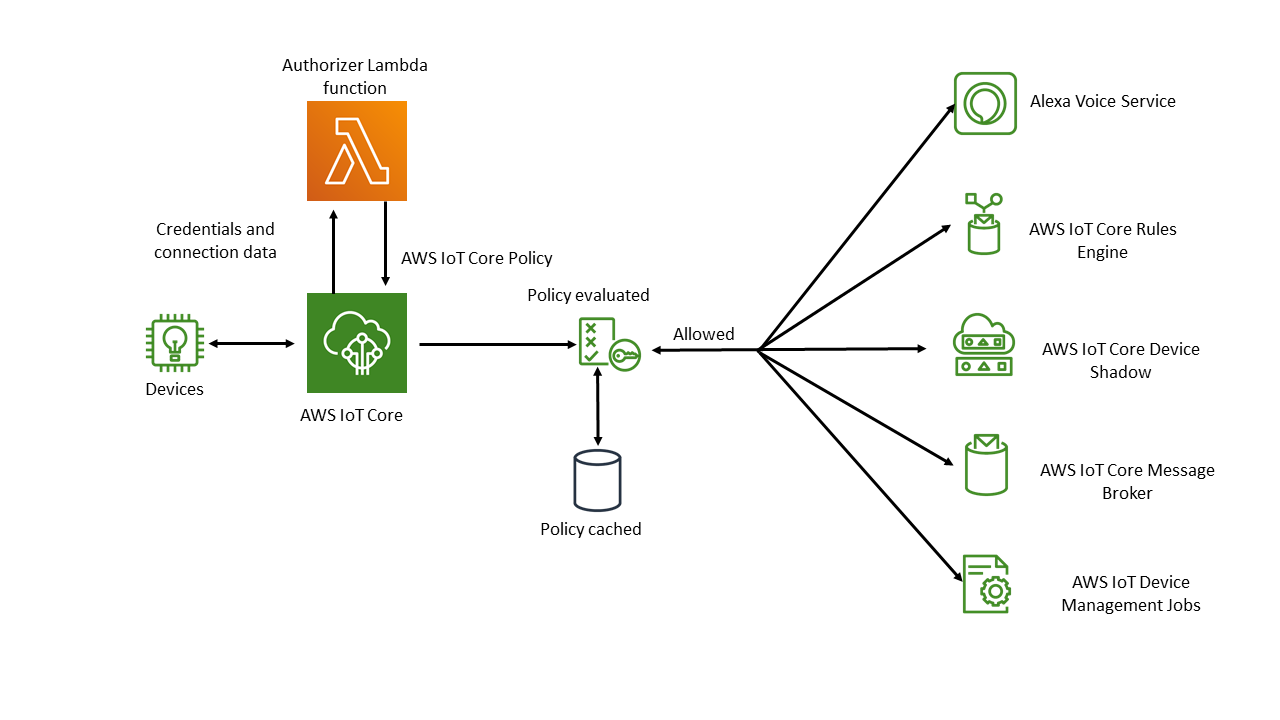Understanding the custom authentication workflow
Custom authentication enables you to define how to authenticate and authorize clients by using authorizer resources. Each authorizer contains a reference to a customer-managed Lambda function, an optional public key for validating device credentials, and additional configuration information. The following diagram illustrates the authorization workflow for custom authentication in AWS IoT Core.

AWS IoT Core custom authentication and authorization workflow
The following list explains each step in the custom authentication and authorization workflow.
-
A device connects to a customer’s AWS IoT Core data endpoint by using one of the supported Device communication protocols. The device passes credentials in either the request’s header fields or query parameters (for the HTTP Publish or MQTT over WebSockets protocols), or in the user name and password field of the MQTT CONNECT message (for the MQTT and MQTT over WebSockets protocols).
-
AWS IoT Core checks for one of two conditions:
-
The incoming request specifies an authorizer.
-
The AWS IoT Core data endpoint receiving the request has a default authorizer configured for it.
If AWS IoT Core finds an authorizer in either of these ways, AWS IoT Core triggers the Lambda function associated with the authorizer.
-
-
(Optional) If you've enabled token signing, AWS IoT Core validates the request signature by using the public key stored in the authorizer before triggering the Lambda function. If validation fails, AWS IoT Core stops the request without invoking the Lambda function.
-
The Lambda function receives the credentials and connection metadata in the request and makes an authentication decision.
-
The Lambda function returns the results of the authentication decision and an AWS IoT Core policy document that specifies what actions are allowed in the connection. The Lambda function also returns information that specifies how often AWS IoT Core revalidates the credentials in the request by invoking the Lambda function.
-
AWS IoT Core evaluates activity on the connection against the policy it has received from the Lambda function.
-
After the connection is established and your custom authorizer Lambda is initially invoked, the next invocation can be delayed for up to 5 minutes on idle connections without any MQTT operations. After that, subsequent invocations will follow the refresh interval in your custom authorizer Lambda. This approach can prevent excessive invocations that could exceed the Lambda concurrency limit of your AWS account.
Scaling considerations
Because a Lambda function handles authentication and authorization for your
authorizer, the function is subject to Lambda pricing and service limits, such as
concurrent execution rate. For more information about Lambda pricing, see Lambda PricingrefreshAfterInSeconds and disconnectAfterInSeconds
parameters in your Lambda function response. For more information about the
contents of your Lambda function response, see Defining your Lambda function.
Note
If you leave signing enabled, you can prevent excessive triggering of your Lambda by unrecognized clients. Consider this before you disable signing in your authorizer.
Note
The Lambda function timeout limit for custom authorizer is 5 seconds.